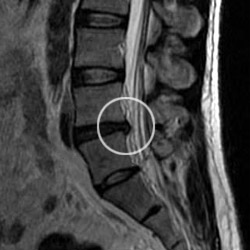
Back pain is incredibly common. In fact, it is normal. 80% of people have it sometimes in their lives. Low back pain (LBP) is the most common type of back pain. It is one of the commonest causes of time off work.
It’s rarely dangerous. Persistent back pain can be distressing, but it’s rarely life-threatening; and you are unlikely to end up in a wheelchair. Backs are strong and most heal within six weeks.
 MRI: showing herniated disc
MRI: showing herniated disc